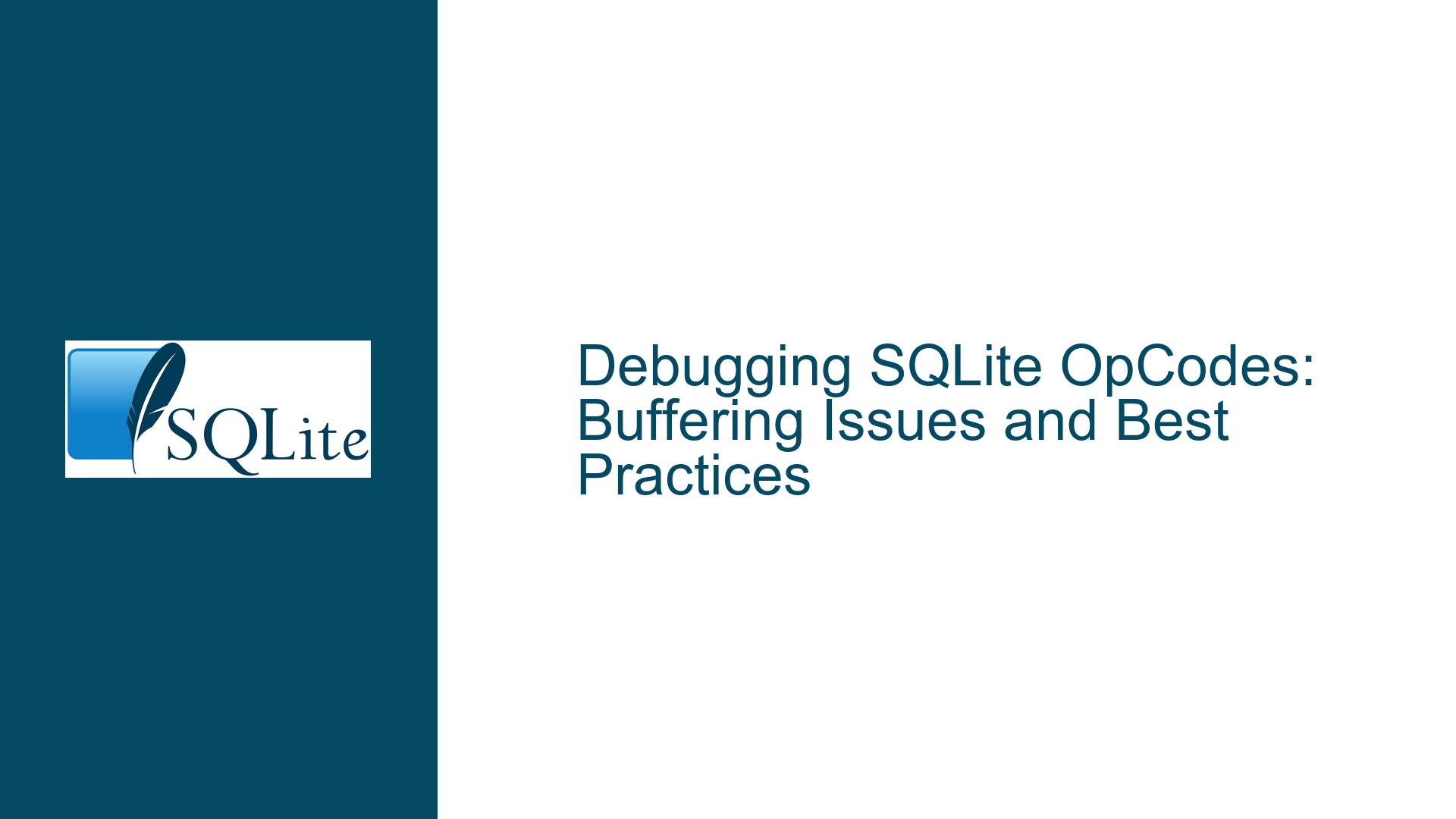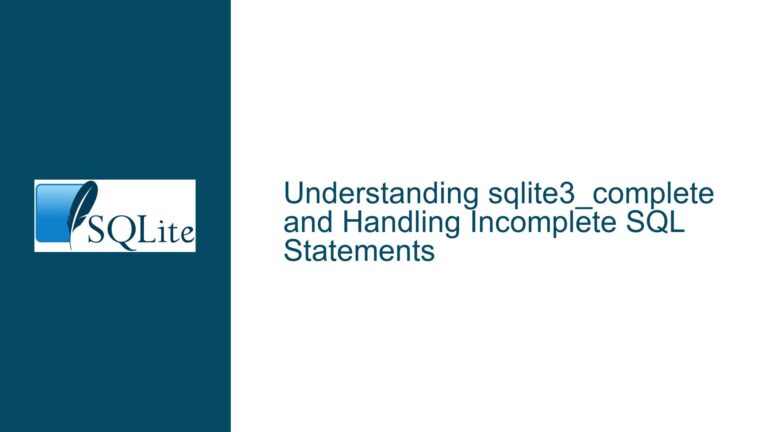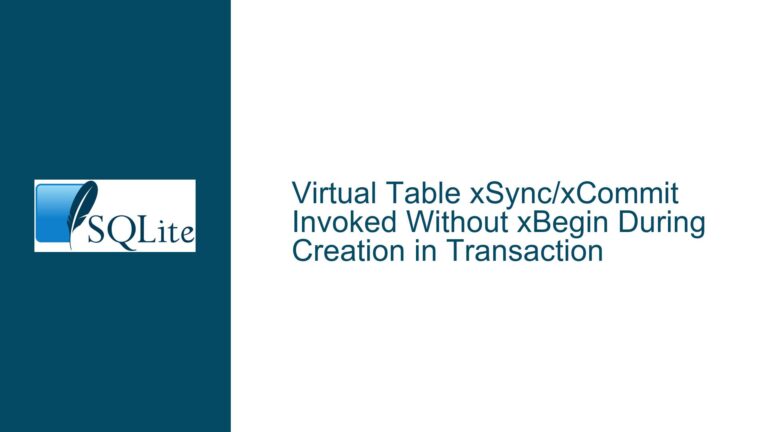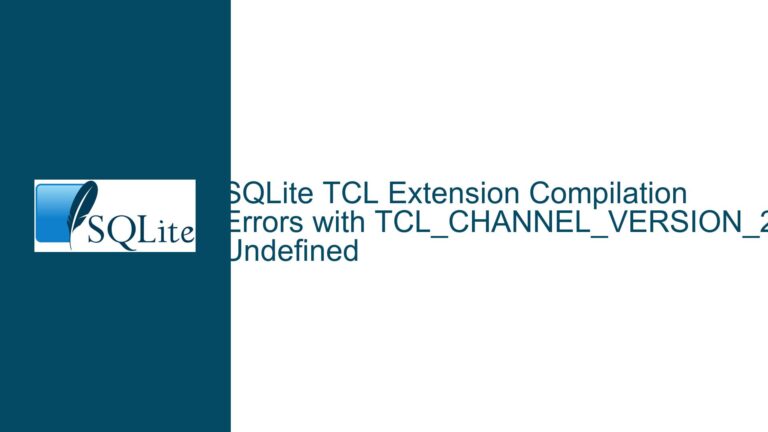Debugging SQLite OpCodes: Buffering Issues and Best Practices
Understanding Buffering Effects on Debugging SQLite OpCodes
When working with SQLite’s Virtual Database Engine (VDBE) and its opcodes, such as IsSmaller, developers often rely on debugging techniques like adding printf statements to trace the execution flow. However, the behavior of these debugging statements can be inconsistent, leading to confusion and misinterpretation of the debugging output. The core issue revolves around the buffering of standard output (stdout) in C, which can cause printf statements to appear out of order or not at all, depending on the execution environment and how the output is redirected.
The IsSmaller opcode, for instance, is primarily triggered by the PRAGMA optimize command, which is exercised in the busy.test script. When debugging this opcode, developers may observe that printf statements within the vdbe.c file sometimes fail to produce the expected output. This inconsistency is not due to a flaw in the opcode’s logic but rather a result of how stdout buffering interacts with the execution environment, such as running the SQLite command-line interface directly versus running it through make test.
The buffering behavior of stdout is influenced by several factors, including whether the output is directed to a terminal or a file, the use of shell redirection operators like > or | tee, and the presence of multiple processes in the execution pipeline. For example, when running make test, the output may be buffered differently compared to running the SQLite binary directly, leading to discrepancies in the timing and visibility of printf statements.
Buffering Mechanisms and Their Impact on Debugging Output
The root cause of the inconsistent printf behavior lies in the buffering mechanisms employed by the C standard library (stdio). By default, stdout is line-buffered when connected to a terminal, meaning that output is flushed to the terminal after each newline character. However, when stdout is redirected to a file or a pipe, it becomes fully buffered, meaning that output is flushed only when the buffer is full or when the program exits. This difference in buffering behavior can lead to unexpected results when debugging, as the output may appear delayed or missing altogether.
For instance, consider the following scenarios:
- Direct Execution: When running the SQLite binary directly in a terminal,
printfstatements are typically line-buffered, and the output appears immediately after each newline. - Redirection to a File: When redirecting the output to a file using
>,stdoutbecomes fully buffered, and the output may not appear until the buffer is flushed, which usually happens when the program exits. - Pipeline Execution: When using a pipeline with
| tee, the buffering behavior can vary depending on the tools involved. Some tools, likesed, may introduce additional buffering, further complicating the timing of the output.
The use of the script command, which captures terminal output, can also affect buffering. The script command flushes the line buffer, causing printf statements to appear exactly when expected. This can mask the buffering issues, making it seem as though the problem has been resolved when it has not.
Best Practices for Reliable Debugging in SQLite
To address the buffering issues and ensure reliable debugging output, developers can adopt several best practices:
- Explicitly Flush
stdout: After eachprintfstatement, explicitly callfflush(stdout)to force the output to be written immediately. This approach ensures that the output appears in the correct order, regardless of the buffering behavior.
printf("Debug message\n");
fflush(stdout);
- Use
sqlite3DebugPrintf: SQLite provides a dedicated debugging function,sqlite3DebugPrintf, which includes an implicitfflushand handles other portability issues. This function is available when SQLite is compiled with the-DSQLITE_DEBUGflag. Usingsqlite3DebugPrintfensures consistent behavior across different platforms and execution environments.
sqlite3DebugPrintf("Debug message\n");
- Leverage
stdbuffor Shell Scripts: When running SQLite through shell scripts or pipelines, thestdbuftool can be used to control the buffering behavior ofstdout. For example,stdbuf -oLcan be used to force line buffering, ensuring that output is flushed after each line.
stdbuf -oL make test | tee output.log
Avoid Unbuffered
stdout: While settingstdoutto unbuffered mode withsetbuf(stdout, NULL)might seem like a solution, it can introduce other issues, especially when dealing with redirections. Instead, rely on explicit flushing or dedicated debugging functions.Consistent Use of Debugging Functions: To improve the maintainability and reliability of debugging code, consider using
sqlite3DebugPrintfconsistently throughout the SQLite source code. This approach centralizes debugging logic and ensures that all debugging output adheres to the same behavior.Document Buffering Behavior: Given the subtle and often confusing nature of buffering issues, it is essential to document the expected behavior of debugging statements, especially when running SQLite in different environments. This documentation can help other developers understand and troubleshoot any discrepancies they encounter.
Conclusion
Debugging SQLite opcodes, such as IsSmaller, requires a deep understanding of the underlying buffering mechanisms and their impact on debugging output. By adopting best practices like explicit flushing, using dedicated debugging functions, and leveraging tools like stdbuf, developers can ensure reliable and consistent debugging output across different execution environments. Additionally, documenting the expected behavior of debugging statements can help mitigate confusion and improve the overall debugging experience.
Summary of Key Points
| Issue | Cause | Solution |
|---|---|---|
Inconsistent printf output | Buffering of stdout in different execution environments | Use fflush(stdout) or sqlite3DebugPrintf |
| Missing or delayed debug output | Fully buffered stdout when redirected to a file or pipe | Force line buffering with stdbuf -oL |
Confusing behavior in make test | Different buffering behavior between direct execution and make test | Document expected behavior and use consistent debugging functions |
| Masking of buffering issues | script command flushes the line buffer, hiding buffering problems | Avoid relying on script for debugging; use explicit flushing |
By following these guidelines, developers can effectively debug SQLite opcodes and avoid the pitfalls associated with stdout buffering.






